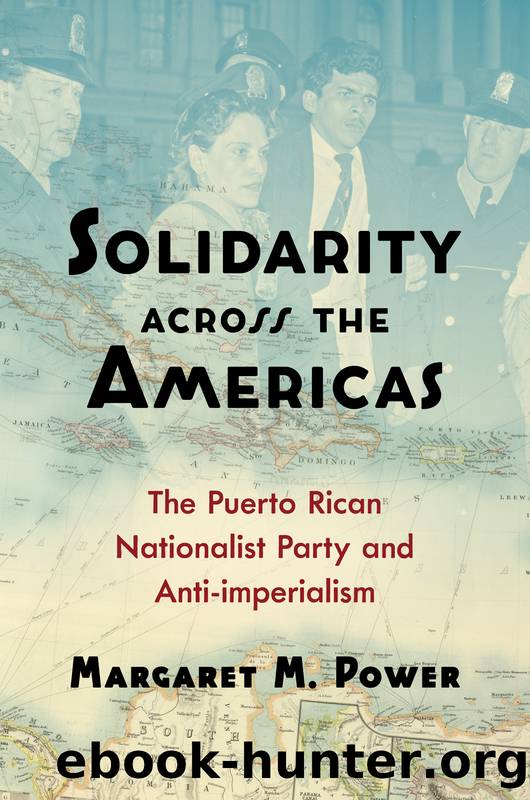Solidarity Across the Americas: The Puerto Rican Nationalist Party and Anti-Imperialism by Margaret M. Power

Author:Margaret M. Power
Language: eng
Format: epub
Publisher: The University of North Carolina Press
Published: 2023-04-15T00:00:00+00:00
The conclusions asserted in these two reports convinced U.S. officials they had to take steps to transform the optics of the United Statesâ relationship with Puerto Rico. They determined that naming a Puerto Rican as governor of the archipelago would improve Americansâ perceptions of the United States. Thus, the U.S. government chose Jesús Piñero, a PPD stalwart whom Muñoz MarÃn backed, to be the governor. In a calculated, if highly ironic move, Truman appointed Piñero governor on July 25, 1946, the forty-eighth anniversary of the U.S. invasion in 1898. The date simultaneously established U.S. control over Puerto Rico and projected the âbenevolentâ nature of that rule by naming a Puerto Rican to run the local government. The next step was to allow Puerto Ricans to vote for their own governor for the first time since 1898. Luis Muñoz MarÃn was the hands-down favorite; he sailed to victory with 61 percent of the vote. In addition, the Popular Democratic Party won control of the position of resident commissioner as well as all but one of the seventy-seven municipalities, the political jurisdictions into which Puerto Rico is divided.53
Although Muñoz MarÃn and the party claimed credit for the new constitution and the end to U.S. colonial rule they said it heralded, Congress had to approve every step in the process, from Public Law 600 to, as we have seen, the new constitution, which many might consider evidence of Puerto Ricoâs ongoing subordinate status. After many discussions between U.S. officials, Muñoz MarÃn and Resident Commissioner Antonio Fernós-Isern, Congress approved the new Puerto Rican constitution on July 3, 1952.54 However, in an act that clarifies to what extent the United States did not plan to relinquish its power in Puerto Rico, Truman declared the existence of the Commonwealth of Puerto Rico on July 25, 1952, more than three months before Puerto Ricans actually voted on it and, once again, on the day when the United States invaded Puerto Rico in 1898.55 When he presented the new constitution to Congress in 1952, Truman took the opportunity to trumpet U.S. virtues and respect for democracy, proclaiming, âThe United States gives evidence once more of its adherence to the principle of self-determination and its devotion to the ideals of freedom and democracy.â56
The U.S. government then seized on Puerto Ricoâs supposed change in status to proclaim to the world that the days of U.S. colonial rule were over. As Henry Cabot Lodge, the patrician U.S. representative to the United Nations, declared to the international body in 1953, âIn light of the change in the constitutional position and status of Puerto Rico, the United States Government considers that it is no longer necessary or appropriate for the United States to continue to transmit information on Puerto Rico under article 73 (e).57 Therefore, the United States Government has decided that with the submission of information for the period July 1, 1951 to June 30, 1952, it will cease to transmit information on Puerto Rico.â58
Both the PNPR and the PIP contested U.S. assertions that Puerto Rico should be taken off the United Nationsâ list.
Download
This site does not store any files on its server. We only index and link to content provided by other sites. Please contact the content providers to delete copyright contents if any and email us, we'll remove relevant links or contents immediately.
| Arms Control | Diplomacy |
| Security | Trades & Tariffs |
| Treaties | African |
| Asian | Australian & Oceanian |
| Canadian | Caribbean & Latin American |
| European | Middle Eastern |
| Russian & Former Soviet Union |
The Secret History by Donna Tartt(18866)
The Social Justice Warrior Handbook by Lisa De Pasquale(12143)
Thirteen Reasons Why by Jay Asher(8804)
This Is How You Lose Her by Junot Diaz(6805)
Weapons of Math Destruction by Cathy O'Neil(6156)
Zero to One by Peter Thiel(5694)
Beartown by Fredrik Backman(5611)
The Myth of the Strong Leader by Archie Brown(5429)
The Fire Next Time by James Baldwin(5253)
How Democracies Die by Steven Levitsky & Daniel Ziblatt(5135)
Promise Me, Dad by Joe Biden(5090)
Stone's Rules by Roger Stone(5029)
A Higher Loyalty: Truth, Lies, and Leadership by James Comey(4853)
100 Deadly Skills by Clint Emerson(4846)
Rise and Kill First by Ronen Bergman(4706)
Secrecy World by Jake Bernstein(4654)
The David Icke Guide to the Global Conspiracy (and how to end it) by David Icke(4629)
The Farm by Tom Rob Smith(4443)
The Doomsday Machine by Daniel Ellsberg(4421)
